|
Originally in: http://www.wetwebmedia.com/ca/WWMDigitalMagV1Ish1.htm,
Related FAQs: African
Cichlids, African Cichlid
Identification, African Cichlid ID
2, African Cichlid Selection,
African Cichlid Behavior,
African Cichlid Compatibility,
African Cichlid
Compatibility 2, African
Cichlid Systems, African Cichlid Systems 2,
Malawi Cichlid Systems, Tanganyikan Systems, African Cichlid Feeding, African Cichlid Disease, African Cichlid Disease 2, African Cichlid Disease 3, African Cichlid Disease 4, African Cichlid Disease 5, African Cichlid Disease 6, African Cichlid Disease 7, African Cichlid Disease 8, & African Cichlid Reproduction,
African Cichlid
Reproduction 2, Cichlids in General: Cichlids of the
World, Cichlid Systems, Cichlid Identification, Cichlid Behavior, Cichlid Compatibility, Cichlid Selection, Cichlid Feeding, Cichlid Disease, Cichlid
Reproduction,
Related
Articles: Malawian
Cichlids: The Mbuna and their Allies By Neale Monks,
The Blue
Followers: the Placidochromis of Lake Malawi by Daniella
Rizzo, Pseudocrenilabrus: Miniature
Mouthbrooders With Attitude! by Neale Monks,
Kribs & Their
Cousins By Neale Monks,
Stocking Lake Malawi Community
Tanks
|
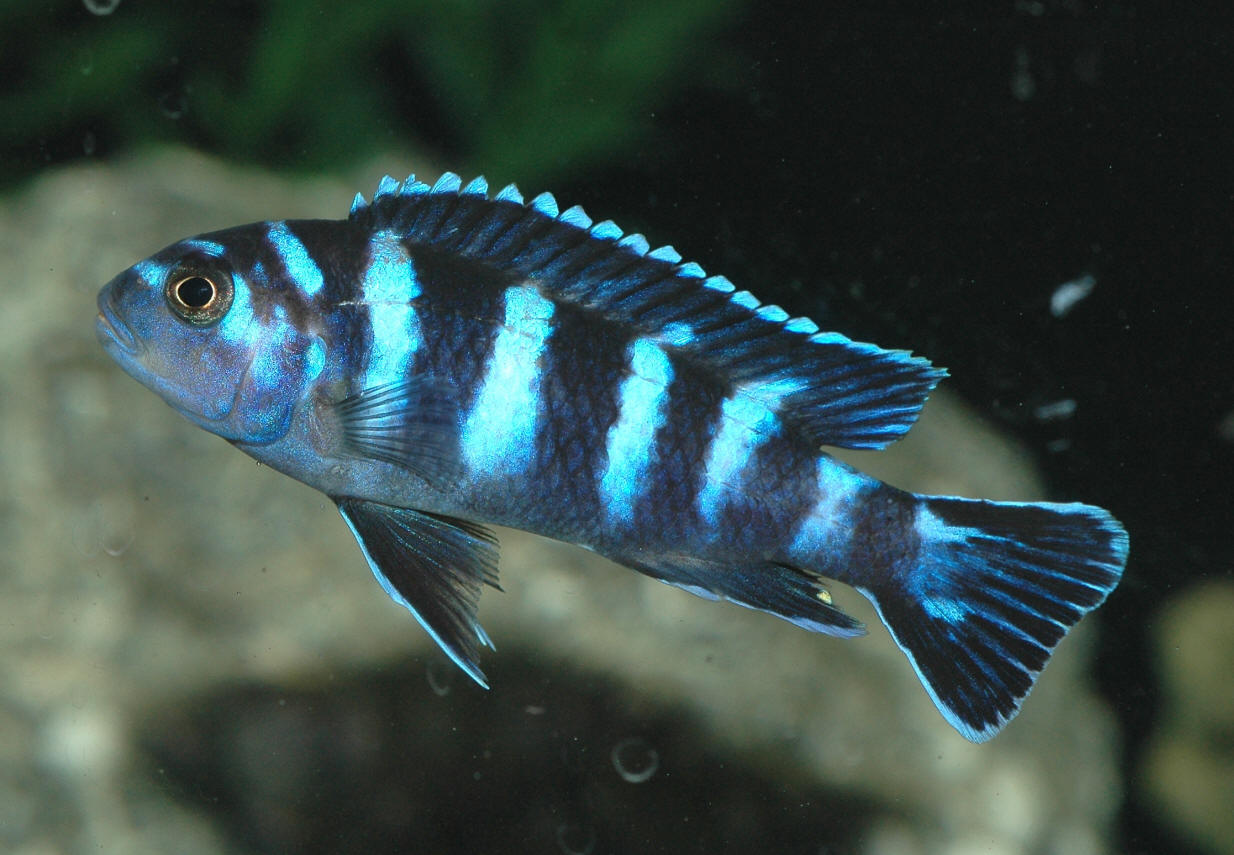
|
|
By Mary Bailey
|
P. demasoni |
One of the most frequently asked questions about
Malawi cichlids is how many can be kept in a specific size of tank, and
what species. Given that the lake is home to hundreds of species,
in a range of sizes, temperaments, habits and habitats, this is not the
sort of question to which there is a brief definitive answer, and any
answer will of necessity involve an element of
over-simplification. Nevertheless, I will endeavor to give below
some guidelines which, coupled with common sense, should help provide
the desired result a workable Malawi cichlid
community.
Compatibility the big picture
First of all, however, I must emphasize that not
all Malawi cichlids are compatible with one another, far from it.
The biggest and commonest mistake most people make is to mix the small,
thuggish, rock-dwelling mbuna (Pseudotropheus,
Melanochromis, & co) with other Malawi cichlids. The
vast majority of mbuna are tied to the rocky habitat, they do not stray
from it, and they live at a remarkably high population density.
This means they are aggressive and territorial.
Other cichlids may spend time in
the rocky areas, but in most species this is optional, in other words
they can beat a hasty retreat away from the danger zone if
attacked. They do not have this option in a glass box. A
few species eg Aulonocara jacobfreibergi, Otopharynx
lithobates are also rock-bound but occupy microhabitats (eg large
caves) which are of little interest to mbuna and so represent havens of
peace and quiet amid the turmoil outside. A number of much larger
species eg Serranochromis robustus, Tyrannochromis spp.
also spend a lot of time in rocky habitats, but they prey on
mbuna!
Another important point is that
not all Malawi cichlids are at home in an underwater rockery, many
require a much more open type of habitat and/or more space.
Habitat is very important to many cichlids, especially when as is
commonplace in Lake Malawi they have specialized on a restricted,
specific environment and the resources it offers.
What all this means is that if you want to keep
mbuna, it is best to keep an mbuna-only community, because cichlids
from other habitats may be actively harassed as they do not have the
temperament to fight back, stressed by the wrong habitat or the busy
nature of the tank, or likely to enjoy an expensive fresh-fish
diet.
To some extent the other
groups for example sand-dwellers (Aulonocara, Lethrinops,
and others), open-water dwellers (eg utaka Copadichromis) can be
mixed, provided size and feeding habits are taken into account.
But that consideration is or should be a basic function of
fishkeeping.
There are sometimes also
questions of compatibility within the various groups, but I will deal
with them separately for each group.
Tank sizes and shapes
There are a number of preliminary
ground rules here, as well. Nowadays tanks tend to be sold by
volume (eg 100 gallons), which is fine if you are dealing with fishes
where only volume is important. For cichlids, however and not
just Malawi cichlids it is shape and size (length, width, sometimes
also height) that are the limiting factors.
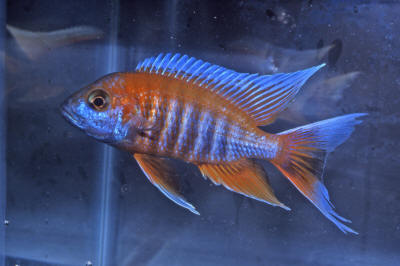
Aulonocara occupy different niches than Mbuna, and suffer if having to
share space with them. MaryB pic
One major criterion of keeping cichlids is
available bottom space (territory) and escape space (tank length)
allowing any fish to get a decent distance away from an
aggressor. 100 gallons could be a tall tower of a tank, a cube, a
triangular corner tank but what Malawi cichlids require is a
traditional long rectangular box unless you are talking about an
immense, public-aquarium-type, tank which is wider than the length of a
normal domestic tank so the escape space is two-dimensional. By
the way, escape upwards is not a solution, because there will be no
cover at the top, the fish will be exposed and stressed, and a sitting
target for any persistent persecutor. And in my experience a
Malawi cichlid trying to hide in an upper corner of a tank will be
picked on by all and sundry, as its behavior is abnormal and invites
attention.
Volume and tank height do assume
a degree of importance with the open water cichlids, but for the rest
it is bottom area that is important.
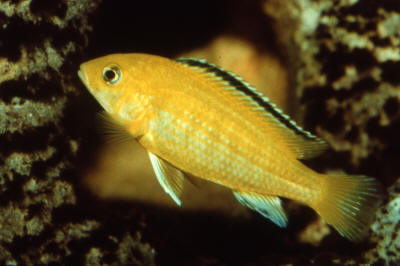
Amongst the gentlest of Mbuna, Labidochromis (caeruleus). MaryB
pic
My final basic rule is that with one exception
only, Malawi cichlids should not be kept in a tank less than 36 inches
(90 cm) long (for example a standard 30-gallon Breeder = 36" x
18" x 12" / 90 x 45 x 30 cm). And a larger tank is far
better. The exception is the mbuna Labidochromis
caeruleus, which is remarkably peaceful and also tolerant of its
own kind, such that it is possible to keep just a pair in a species
tank and not end up with just a male. This makes it the ideal
species for anyone wanting to simply try their hand, or who has very
limited space. But please do not try it with any other Malawi
cichlid, unless you are keeping just one fish otherwise you will
probably end up with just one fish!
Mbuna
Malawi cichlids are, with a very
few exceptions (not generally maintained in aquaria), maternal
mouthbrooders with no permanent pairing, although some live in
non-territorial mixed-sex shoals or bottom-foraging parties outside the
breeding season. Mbuna are sedentary, with dominant males holding
territory and non-territorial males and females trying to eke out a
living while avoiding attack by territory-holders. When a female
is ripe she seeks out a male but the rest of the time she maintains her
distance. This is not so easy to do in the aquarium, and the
presence of a female so near to the male sends him the wrong
signals. He thinks she wants to spawn, she is unwilling, unable,
so courtship rapidly turns to attack. This is why mbuna tanks
need to have plenty of cover (as in nature), a high population density
(to distract the males), and that essential length to provide escape
distance. Ironically, although mbuna are among the smallest
Malawi cichlids, they are also the most territorial and hence the most
difficult.
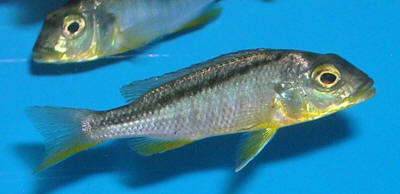
Buccochromis rhoadesii, up to a foot in length, though not
being overly aggressive, is only safe w/ fishes of similar size. Neale
Monks pic.
Many years ago I devised a formula based on a lot
of practical experience for calculating the number of inches (TL) of
adult mbuna that can be kept relative to the bottom area
available: 20-24 inches (50-60 cm) of fish per square foot (144
sq. in or 900 sq. cm) of tank bottom. This worked very well for
me, and it has worked for countless other cichlid enthusiasts to whom
Ive communicated it, one to one or via my books and articles. At
least, nobody has ever complained that Im wrong! Using this
formula the 30 gallon Breeder (36" x 18" x 12" / 90 x 45
x 30 cm) mentioned earlier has a bottom area of 36 x 18 = 648 sq. in,
or (dividing by 144) 4.5 square feet, and will thus house 4.5 x 20- 24
inches of mbuna, which gives us 90-108 inches. The average mbuna
measures about 4-5 inches (10-12.5 cm) so the tank will (and should)
house 23-27 adult mbuna. It doesnt have to be precise, but has
proved a very good rule of thumb. Do not drop too far below the
recommended population density or aggression problems are likely;
you can cram more fish in within reason as long as you are prepared to
work harder on maintaining water quality.
Degrees of aggression
However, mbuna come in various
degrees of aggression and territoriality, which I usually group into
peaceful (by mbuna standards), nasty, and the rest. These should
govern what species you mix, and are only partially dependent on size
and genus:
- Peaceful: all
Labidochromis, Labeotropheus trewavasae,
Pseudotropheus socolofi, Ps. demasoni,
Ps. sp. elongatus XXX with stripes on the forehead (another
rule of thumb), Tropheops, the small blue Melanochromis
such as johanni and cyaneorhabdus, Metriaclima
(except M. lombardoi), Iodotropheus;
- Nasty:
Petrotilapia (by virtue of their large size),
Pseudotropheus sp. elongatus XXX with no stripes on the
forehead (males are often psychopaths, best avoided), large
wild-caught males of Labeotropheus fuelleborni and the larger
Melanochromis (ingrained aggression), Genyochromis
mento (fin-eater, do not even try to keep);
- The
rest.

Labeotropheus fuelleborni RMF
pic
Note that the small Cynotilapia species
fall under the rest as their territoriality is out of proportion to
their size, but they lack clout, being small. So while they may
cause trouble with peaceful-group tankmates of their own size, they
will think twice about tackling a larger fish (but can look after
themselves if a larger fish starts a squabble). Cichlid-keeping
is all about psychology!
My criteria are based on males, as it is their
territoriality that is the governing factor. Females can become
territorial if no conspecific male is present, but not to the same
extent. There is an element of overlap between groups:
occasional rogue fish (uncharacteristically peaceful or aggressive for
the species) crop up, individual territoriality often increases with
size and age, and wild fish can be expected to be more territorial than
long-term tank-bred. But again the system has proved itself in
practice.
The peaceful group are the only species that
should be kept in a tank with the minimum Malawi length of 36 (90 cm),
but they can be kept in larger tanks as well, and can be mixed with
species from the rest, for which minimum tank length is 48 (120 cm), eg
a standard 55 gallon (48" x 13" x 21" / 120 x 35 x 55
cm). The rest can in turn be kept with the nasty group, but for
that group minimum tank length is 72 (180 cm), eg a standard 180 gallon
(72" x 24" x 25" / 180 x 60 x 62 cm).
Look-alikes are more likely to squabble than
dissimilar species, which brings me to my last mbuna rule: NEVER
have more than one longitudinally-striped Melanochromis species
in a tank, as the stripe pattern (color irrelevant) is like a red rag
to a bull. But they rarely squabble much with vertical stripes
unless the latter start it. By the same token, except in very
large tanks it is inadvisable to have more than one male of a
species; if you must have more then make it an odd number as only
two can fight at once, so theres an opportunity for each to take a
break in turn!
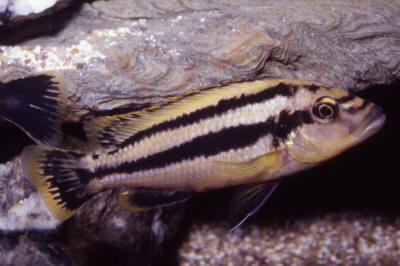
Don't mix longitudinally-banded Melanochromis species as
they'll fight. A female M. chipokae shown. MaryB pic
Small sand-dwellers and utaka
Small sand-dwellers
Aulonocara, some Lethrinops, and some small haps such as
Placidochromis electra and Cyrtocara moorii mix well with
utaka, the open-water plankton feeders (mostly the genus
Copadichromis). Most of these fishes have some association
with rocks: utaka are typically found in open water near to a
rocky backdrop or over rocks, and most small sand-dwellers are either
found where rocks meet sand or go there to breed. All these
cichlids are relatively peaceful and will mix well in a tank with a
rocky backdrop (not necessarily in the tank) and some rocks on the
bottom.
Alternatively the two groups can be kept
separately, but in that case either the bottom or the top part of the
tank will be fish-free, which is a waste.
Utaka are shoaling fishes immense shoals of
hundreds or thousands when plankton is plentiful so they need to be
kept in reasonable numbers. Keeping a single pair of
Copadichromis is not kind. But you dont have to have a
single-species shoal, as a mix of species works well with a couple of
provisos: firstly, choose species that live together in the wild
or that are very different in appearance, including the
females. The former will have built-in mechanisms to prevent
hybridization, while the latter will be able to tell visually who is
the right mate. Otherwise there is a very real risk of crossing,
as many species are closely related; a lot of supposed C.
borleyi in the trade are actually hybrids. Secondly, if
possible select species with different-looking females so you
can tell them apart yourself. Otherwise, how will you know what
the fry are unless you grow them up to full size so the males color
up?!
Similar ID strictures apply to Aulonocara
species, which again often have very similar females and are notorious
for hybridizing as the males cant tell them apart. Do not, for
example, mix the stuartgranti types together, but by all means
mix a stuartgranti with jacobfreibergi and/or one of the
blaze species (maylandi Sulfurhead Aulonocara,
kandeense Blue Orchid).
When it comes to tank size, an Aulonocara
species tank (one species) can be the Malawi minimum length of 36 (90
cm), but normally the starting point will be a 48 (120
cm). If keeping just the bottom dwellers then depth
is relatively unimportant, but for utaka the tank will ideally be at
least 24 (60 cm) deep to allow for a decent amount of swimming
space. A 180 gallon (72" x 24" x 25" / 180 x 60 x
62 cm) would be an excellent choice.
For stocking density, as a rough guide use half
the mbuna rate for the bottom dwellers 10-12 inches (TL) of adult fish
(roughly 2 fishes) per square foot (900 sq cm) of bottom area;
these fishes do not lead such a crowded existence as mbuna. And
for the utaka use the mbuna formula, but adding 25% for every extra 6
(15 cm) of depth over the basic 24 (60 cm), because for this group
volume (all three dimensions) is actually a factor. Thus the
above-mentioned 72" x 24" x 25" (180 x 60 x 62 cm) will
hold 20-24 of adult utaka per square foot (900 sq cm), but if we
increase the depth to 30 (75 cm) you can have 25-32 inches of adult
fish (TL) per square foot, and thats in addition to any
Aulonocara, etc on the bottom. For those who prefer to
work in volume, thats
1.3-1.6 [ 1] of utaka per (US) gallon and the
above-mentioned 180-gallon tank would house about three dozen of them
when adult. Here, however, there is no minimum stocking rate as
long as you have a reasonable group.
Big Malawis
This group is a convenience rather than a natural
entity, and based only on size. It comprises numerous genera,
many of them quite small and sometimes with behavioral and habitat
variation within the genus. It is essential to research each
species individually (I recommend Ad Konings Malawi Cichlids in
their Natural Habitat www.cichlidpress.com) and use common
sense when mixing species, or as to whether to mix them at all.
The only other universal stipulation here is that the tank must be
large, at least 72 (180 cm) for a community, eg a 180 gallon (72"
x 24" x 25" / 180 x 60 x 62 cm). It may be possible to
keep a pair or small group of one species in a 48 (120 cm), but because
the fishes are large a reasonable width and depth are required as well
as length, eg a 90 gallon (48" x 18" x 24" / 120 x 45 x
60 cm).
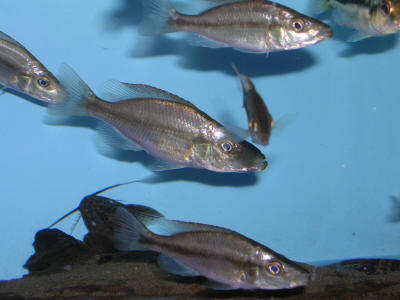
Dimidochromis compressiceps are peaceful (though predatory) and bullied
by Mbuna, but mix well w/ Aulonocara, Utaka and Haps. Photo by Neale
Monks
It is questionable whether some species can be
kept in domestic aquaria at all, other than as singles, if then.
The lifestyle of Taeniolethrinops praeorbitalis, for example,
involves travelling over large expanses of shallow sandy or muddy
bottom sifting the substrate for food. The smaller ncheni
(Rhamphochromis open water pursuit predators) have been kept and
bred successfully in large aquaria, but some are large and cover huge
distances in their normal wild life. Then there is
Fossorochromis rostratus, another sifter that is occasionally
imported, usually only males as only males are colorful. They
seem to be impossible to keep except alone. This does not
surprise me. A sandy bay several hundred yards long in Lake
Malawi will harbor countless female and juvenile Rostratus, when you
wash dishes in the lake they come scavenging and they check out your
toes when you paddle. But if you snorkel in that bay you will
find just one adult, colored male, master of all he surveys. We
cannot hope to reproduce that sort of environment. I feel that
some species, especially those that range widely or enjoy immense
territories, are best left in the lake.
Sex ratios
Finally, another question
associated with stocking how many females per male? In the early
days when only wild fishes were available there was no choice unless
you were very lucky, as they were usually imported in pairs. And
we got by. Nowadays it is usually possible to get additional
females if desired. With species where males are hard on females,
the advantage of more than one female per male is obvious any
persecution is spread so harm is less likely. The downside is
that multiple females means less variety of species, and also that when
your Malawis breed as they probably will you may have a glut of
youngsters that you cant sell.
Some people choose to have only
males, as they are often more colorful and there will be no harassment
of females, plus the aquarist may not want to breed his fish. But
in my view there are serious ethical questions about keeping cichlids
in which breeding and parenthood plays a particularly important role
and not allowing them to breed. Besides which, their breeding
behavior is a major part of their charm. There are other colorful
fishes if color is all you want.
Last but not least: it is
fine to keep a celibate male for a while if his female is lost, but
NEVER keep a single female in the company of a male of a closely
related species (same group, eg any other mbuna, any other utaka) or
you will have hybridization, and usually the cross is fertile and you
will have a brood to destroy. Even hybrids between groups are
possible, so the situation is best avoided.
As I said at the beginning of
this article, it is impossible to cover all eventualities where so much
variety is concerned. But I hope I have at least given you a
starting point, and some ideas, about what and how many Malawis to
keep.
Haps/Peacock Stocking Options for 330 G tank
Stocking Options for a 330 G Malawi Cichlid Tank
– 11/20/12
Hello Crew: I`m new to this hobby - and I really love your site. I
have a new (for me) 330 G tank that I set up this fall (2` x 2` x 12`).
Currently, the water parameters are as follows: pH @ 7.8, ammonia
0, nitrites 0, nitrates 60, water temp. @74.5F. My water is
naturally on the hard side. I tried some live plants, but they did
not survive the cichlids. I have three live plants left, some
plastic plants, lots of rock: marble, limestone, river rock, and
about 1/3 of the tank is covered in sand, no obstructions - for the
peacocks. I have a Rena XP3 filter with Purigen and Super Elite
activated carbon in the filter trays, along with the other media, two
110 Aqua Clear HOB filters, 2 Aqua Clear 70 pumps, and 2 blue Poret
filters with water lifters in them. I have two large pieces of
drift wood with many caves near the rocks. I do about a 25% water
change week 1, and about a 40% water change week 2. I try to fast
them one day a week, but its hard not to feed them, especially when they
do their `little dances`.
I started myself off with a few mixed Mbuna in a 70G before I found this
large, custom built tank that came with stock. After it was set
up, while I was away on holidays, my spouse moved all the fish into the
large tank and disposed of the 70G. :( I now have the
following stock in the big tank:
6-7 Labidochromis Caeruleus (aka "Yellow labs"; 2 @ 3'', the rest
various sizes)
5 Iodotropheus sprengerae (aka "Rustys")
* Protomelas taelianautas (aka "Super Red Empress"; 1 dominant male
beautifully coloured @ 51/2'' He is the second dominant tank boss, 2
subdominant males @ 5'' that have taken on the female colouring,
numerous females)
2 Metriaclima Estherae (aka "Red Zebra"; 1 @ 3'', 1@ 2'' )
1 Metriaclima Estherae OB - 1 ''
1 Pseudotropheus sp. Acei (aka "Yellow Tail Acei")
* Otopharynx lithobates 'Mumbo Is.' - and I think there are a few
'Zimbabwe Rock' also - (aka ''Sulphur Head'') - 1 white blaze male
@5'' who is my tank boss, 2 subdominant males that take on the female
colouring about the same size as the dominant male, numerous females)
* Capadichormis chrysonotus 2 males, several females
2 Metriaclima Lombardoi (aka Kennys; both males @ 31/2''
each)
1 Labeotropheus OB fuelleborni (about 3'')
2 Aulonocara Jacobfreibergi 'Eureka' Peacocks (1@ 3'', 1 @
2'')
2 Melanochromis Johanni (aka electric blue johanni, 2 males)
5 Hemichromis binnaculatus (Blood Red Jewel Cichlids -
juveniles - 2 males, 3 females less than 2 '')
5 Aulonocara Peacocks - Rueben Reds - juveniles - too young
to tell sexes yet @ 1 ''
1 Red Top Hongi (male about 3'')
1 Melanochromis hybrid ? (Started out as silvery
pink, now has coloured up similar to the electric blue johanni but is
larger and is relatively peaceful @3 1/2'')
1 Giant Sailfin Pleco (@14'')
1 Medium size sail fin Pleco @ 7''
1 Cuckoo catfish @ 2 1/2'')
2 Bristlenose catfish @ 3'')
1 Freshwater crayfish - Procambarus Clarkii sp. orange
*The females are similar: silver with three black splotches or
silver with black line below lateral line, sometimes with or without
blotches. All together, there is about 16 of them in various
sizes.
I have read many articles that state it is not wise to keep
haps/peacocks together with Mbuna, including Mary Bailey`s on this site,
except for the very peaceful species such as the yellow labs and Rustys.
This is the reason why I am re-homing the other Mbuna. While the red
zebra and kennys have not killed any fish, they are very territorial and
will not let others near their claimed homes. The ones left are all
peaceful - for now. Will have to wait and see about the other red zebra
and OB red zebra which are still small, and no trouble at the moment. If
that changes, I can re-home them later.
Along with the two kennys, and the large red zebra, I`m re-homing the
medium sized sailfin Pleco. I will keep the yellow labs, the
Rustys and yellow tail acei with the haps and peacocks. I know
that the yellow tail acei is a schooling fish so I will likely get 4
more. I`ve heard the same about the cuckoo cats. Should I
get another one?
< If your cuckoo cat is a Syn. multipunctatus then a few more will make
them feel more at home.>
My main concern is that I read conflicting info about peacocks/haps in
terms of mixing species. It is clear that it is not good to mix
species with similar looking females due to cross breeding and
hybridization. However, an article I read suggested that you can
keep 4 different species of Aulonocara if you pick one from each of the
following sub-groups: Chitande, Jacobfreibergi, Stuartgranti, and
sand dwellers (like Gertrudae). So far, from my reseach,
I discerned that the Otopharynx falls into the Chitande sub-group,
correct?
< The genus Aulonocara is characterized by the cichlids having a series
of pores along the bottom of the jaw that that pick up vibrations of
food items living in the sand. Cichlids without this feature are not
placed in the genus Aulonocara. The Otopharynx is not a peacock. In the
hobby it is usually placed in the hap group.>
The Eureka peacock falls into the Jacobfreibergi sub-group, correct?
< Correct >
So I could then select a Stuartgranti species such as the Stuartgranti
maleri or Ngara species? As for the sand dwellers, I do not want
any at the moment. Was this article accurate? Can I also get
the Stuartgranti ("yellow Regal") or Ngara ("Flametail") with the other
Aulonocara or is this inviting cross breeding?
< Generally, blue colored peacocks and the Jake groups do best in Malawi
community cichlid tanks. Yellows do best in a species only tank. I would
recommend getting males only unless you are planning on breeding
them.>
Afterwards, I am looking forward to adding some Copadichromis borleyi
(Kandango) and Copadichromis . Can I, or is it better to select
only one from these two sub-groups?
< Go with the borleyi since the females will have some color on
the fins.>
Or in other words, does the rule about
Aulonocara apply to the other species as well?
< Here is how it works. If you have this big tank full of blue fish, the
females will breed with the dominant blue fish. This means your fish
will cross breed and your tank will have numerous little strange
cichlids that don't look like anything.>
I would also like to get one Crytocara Moorii (aka "dolphin head").
To this mix, can I add Protomelas sp. steveni Taiwan (Taiwan Reef) or
Protomelas sp. spilonotus Tanzania (Liuli) or will this be inviting
cross breeding?
< Yes>
I also like the following fish: Pundamillia nyererei, Cynotilapia
Afra (Cobue), Haplochromis ''ruby green'', Pseudotropheus demasoni,
Pseudotropheus Saulosi, and Pseudotropheus Socolofi and I have
considered some Lethrinops. I prefer to keep the fish smaller than
the 6 inch length, a few bigger are OK but I don`t want to get too much
into species larger than 10 inches. I prefer more herbivores than
carnivores. My concern is that I would like to utilize all of the
tank, not just the mid section or bottom.
I appreciate selecting stock is very individual, but I would be
interested in hearing your suggestions on stocking this tank.
< Skip the Victorians. They will have a difficult time competing with
the Malawi cichlids. In my Malawi tank all the fish have color or at the
least an interesting pattern and get along. I would recommend the
following:
Yellow labs ( Good stock have a orange -yellow color with black fins) or
Labidochromis chisumulae ( Blue male with white female).
Rustys ( Both sexes look alike)
Ps Saulosi ( Blue striped male with yellow orange female) or Ps demasoni
(Both sexes are blue with black stripes).
Ps acei ( Both sexes look alike, feeds on algae on driftwood )
Ps lanistacola ( Malawi shell dweller)
Mel parallelus ( Black male with blue horizontal stripes, females are
white with black horizontal stripes)
Red Fin ( Colorful male and females are silver grey with red fins)
Red Top L. trewavasae ( Blue male with red dorsal fin, females are a
bright orange color.) or L fuelleborni Marmalade Cat ( beautiful mottled
fish)
C. moorii ( both sexes look alike but get big humps on their foreheads)
You get the idea. Keep all the fish colorful unless you are interested
in breeding. Then keep them in a species only tank.>
As for the high nitrates, have you heard of Maglife USA`s new substrate,
Nitrastrate that is naturally buoyant and reduces nitrates? Has
anyone tried it? Does it work? Do the fish like it? I
am in the process of setting up a refugium to cycle the fish water
through that will help reduce the nitrates
< Nitrates are converted to Nitrogen gas by anaerobic bacteria. I would
increase the filter maintenance, occasionally vacuum the gravel,
and try a vegetable based fish food high in Spirulina to reduce the
nitrates. Haven't heard of the product but have seen similar claims on
products over the years that may work for awhile.-Chuck>
Re: Haps/Peacock Stocking Options for 330 G tank 11/22/12
Stocking a 330 Gallon Malawi Cichlid Tank II
Thanks for your insight and comments, Chuck! Yes, my catfish is a
Syn. multipunctatus so I will add two more. Thanks for the
clarification on the peacocks. The species you recommend seem to
be sufficiently different from one another so as to discourage cross
breeding. I'll do more research on the stock you suggested and
then decide. With your suggested stock list, does Mary Bailey's
rule of thumb re: inches of fish/square foot of tank still apply?
< Since most cichlids are territorial it is wise to be aware or there
passion for their own area. Mary's rule is s good place to start but it
is not species specific. I would give a little more space to some of the
more aggressive species like Ps elongatus types and very little
territory to the less aggressive species like the Ps. acei . When it
comes right down to all fish are individuals and you will have to watch
you fish to determine the limits of their territories.>
What vegetable based fish food have you used with good results?
< When you look at the ingredients listed on the package for Spirulina
food you will see fish meal as the first main ingredient. This is
because fish will not eat pure Spirulina. Spirulina should be
lists close to the top as a list of ingredients. I feed Zoomed Spirulina
20, OSI also makes a very good food. Some brine shrimp flake and
plankton flake fed sporadically will enhance the fishes colors. Stay
away from any type of worm food. Lake Malawi cichlids don't do well on
bloodworms, glassworms or earthworm flake.>
I live in a rural area, so my LFS is very limited in choices so I will
likely have to order on line.
< Good luck.-Chuck> Cheers, AW.

